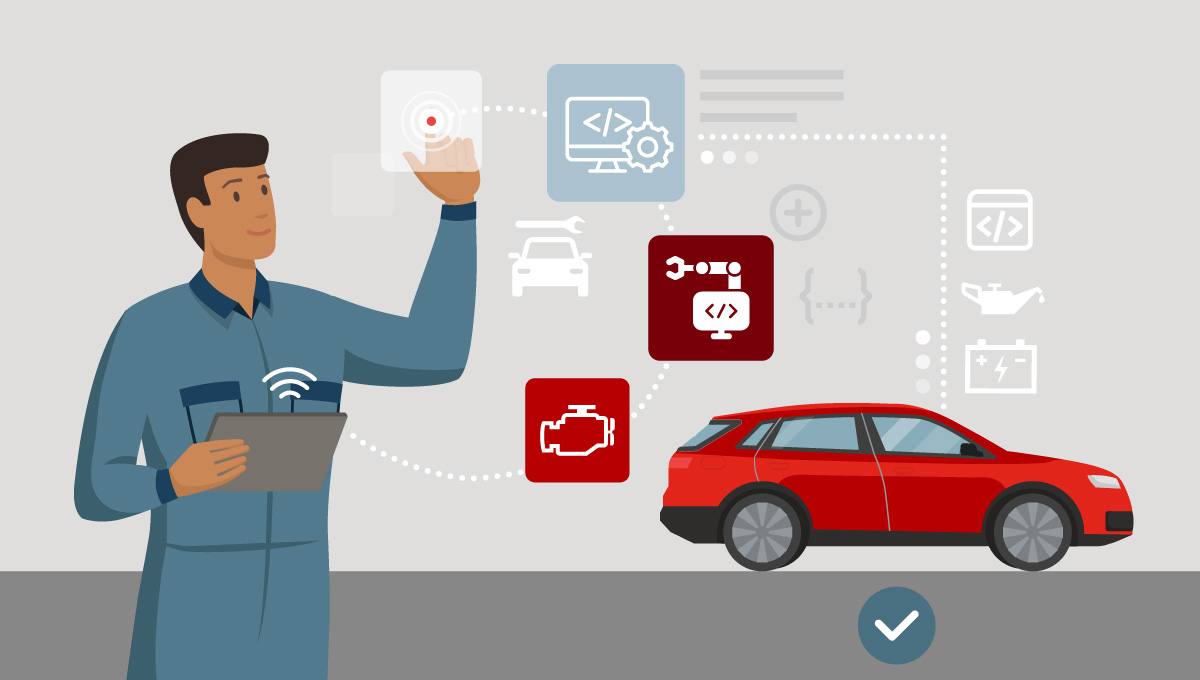
The traditional paradigms of automotive manufacturing are evolving, driven by the imperative to integrate cutting-edge software solutions seamlessly with hardware production. As automotive companies navigate this transformative landscape, the need for end-to-end visibility in production processes becomes increasingly evident.
This blog discusses the critical role of end-to-end visibility in scaling and streamlining automotive production. By identifying key challenges and proposing actionable solutions, we aim to shed light on the strategies necessary for success in the industry’s dynamic landscape.
A Shifting Reality for the Auto Industry
Automotive companies are increasingly confronted with the intricate task of synchronizing software development timelines with deadlines for vehicle launches. Unlike traditional manufacturing processes characterized by tangible endpoints, software development for vehicles is inherently iterative and demands agility to keep pace with evolving technological requirements. This divergence between software and hardware cycles poses significant challenges, particularly for OEMs typically focused on manufacturing. Three challenges, in particular, are driving the automotive industry’s software revolution.
Firstly, while OEMs may excel in specific software domains like advanced driver assistance systems (ADAS), they often lack the breadth of expertise necessary to cover all vehicle functionalities. Acquiring such comprehensive skills presents a formidable and resource-intensive endeavor.
Secondly, tech companies boast unparalleled proficiency in software development, yet their lack of access to the required vehicles hampers their ability to fully capitalize on market opportunities.
Lastly, established tier-one suppliers are grappling with dual challenges: a scarcity of comprehensive software expertise and a dearth of suitable hardware platforms for deployment. This confluence of factors impedes their agility and responsiveness.
Research from McKinsey underscored the urgency of addressing these software development challenges, revealing a stark reality where only 40% of R&D leaders in the automotive sector feel adequately equipped to navigate these complexities. This statistic serves as a call to action for automotive manufacturers and suppliers to prioritize the enhancement of their software development capabilities.
Aligning Software and Hardware Delivery to Reduce Costs
As OEMs tackle the intricate task of synchronizing software development and product launch timelines, disparities often emerge, particularly in the allocation of resources. Often, the number of product managers across all vehicle models is far higher than that of software development managers, who must ensure the alignment of software delivery with the launch dates for the entire line of models. This scenario extends beyond OEMs to tier 2 suppliers, who face similar challenges amplified at the R&D level, where software and hardware integration is pivotal to cost reduction.
To effectively address these disconnects, the automotive industry must embark on a journey of consolidation, marked by implementing new processes, integrations, and partnerships to enhance operational efficiency. Here’s how this objective can be realized:
Integrate the Software Development Toolchain: By integrating software toolchains, companies can unify value streams across the entire production lifecycle—from design to launch. This integration serves as a bridge between software and physical manufacturing processes.
Create Better Alignment Between Teams: Fostering improved alignment among cross-functional, internal, and external teams establishes clear communication and collaboration channels, which is essential to ensure that various stakeholders work toward shared goals and objectives.
Continuous Alignment with Market Demands: Continuously synchronizing the digital and physical aspects of automotive production with evolving market demands necessitates a high degree of responsiveness to market fluctuations, enabling companies to meet customer needs promptly.
Improve Cycle Time and Efficiency: This optimization leads to savings on engineering and development expenses and enables resources to be reallocated efficiently to other programs upon the completion of development phases.
Addressing these disconnects in automotive development and production streamlines operations and enhances competitiveness in a dynamic market landscape.
Minimizing Complexity by Streamlining Effort
Efficient software delivery in the automotive industry demands a strategic approach to minimize complexity and streamline operations cost-effectively. Central to this endeavor is reducing the effort required for software development and maintenance. Achieving this goal hinges on implementing real-time status indicators across all development processes, complemented by robust reporting mechanisms that facilitate the immediate identification of risk areas.
Moreover, aligning software delivery roadmaps with vehicle launch timelines is imperative to prevent costly delays and optimize resource allocation. Failure to synchronize these timelines can result in resource wastage, particularly in manufacturing plants where production may grind to a halt due to delays in software delivery. This emphasizes the critical importance of harmonizing software development efforts with overall production schedules to minimize disruptions and ensure efficient automotive manufacturing processes.
Eliminate “Blackholes” by Consolidating Development Work.
In striving to enhance software delivery processes, there’s a crucial need to address the challenge of collecting and consolidating software development work effectively. This entails eliminating “black holes,” where crucial information or tasks may fall through the cracks. While consolidation is a fundamental step, it is complemented by advancements in AI and automation, which are particularly valuable in record-keeping processes related to traceability. Automation tools ensure companies are tackling the correct problems and addressing issues promptly and accurately.
Another key aspect of streamlining is reducing fragmentation within development processes that result from poor integration. This proves especially beneficial for OEMs and suppliers, where integration of software components is critical for product success.
Furthermore, enhancing governance and consolidating data are instrumental in improving speed and efficiency. Companies can expedite processes and respond more effectively to evolving market demands when decision-making is based on reliable, verifiable information consolidated through effective governance mechanisms.
A global automotive manufacturer rapidly accelerated innovation and delivery through automated synchronization. Read their story here.
Ensuring End-to-End Visibility at All Levels
Comprehensive visibility enables companies to identify areas for improvement and pivot effectively, ensuring that resources are allocated optimally and efforts are focused on value-added activities.
A crucial advantage of enhancing visibility is the ability to distinguish between value-added work and activities that merely act as cost centers. Companies can synchronize operations and maximize efficiency by identifying tasks that contribute positively to the development process and those that hinder progress or consume resources disproportionately.
Moreover, having insight into scalability needs is essential for adapting to the evolving landscape of the automotive industry. This includes anticipating changes in demand, technology, or market dynamics and adjusting methods accordingly. By proactively addressing scalability requirements, companies can position themselves for long-term success and ensure that their software delivery processes remain agile and responsive to industry developments.
Putting it all Together
The automotive industry’s shifting demands and rapid changes continue to uncover unique challenges for automakers. Given the intrinsic nature of software development, characterized by its agility and pace, these challenges are further complicated. Skill gaps within teams provide an added layer of complexity, hindering the seamless integration of software and hardware timelines.
To effectively address these challenges, there is a pressing need for better consolidation of processes, tools, and teams. This entails streamlining work in a more visible and connected manner, achieved through strategies including:
- Consolidating software development work to eliminate “black holes” and delays.
- Implementation of real-time status indicators and reporting mechanisms.
- Alignment of software delivery roadmaps with vehicle launch timelines.
- Adoption of AI with human oversight to automate record-keeping and traceability.
- Minimizing fragmentation within development processes to enhance integration.
- Enhancing end-to-end visibility to improve decision-making.
By implementing these measures, automotive organizations can simultaneously streamline operations while identifying value-added work to gain insights into scalability needs. Ultimately, these efforts enable organizations to move faster at scale, mitigate risks effectively, and increase revenue generation potential.
Embracing a holistic approach to software development and manufacturing integration is essential for successfully navigating the automotive industry’s complexities. To learn more about how building end-to-end visibility into your automotive production process can help you scale capabilities and speed delivery, check out our ebook Accelerating Software Delivery: A Tech Executive’s Roadmap for Predictable Time-to-Value.




